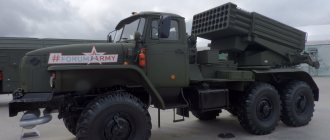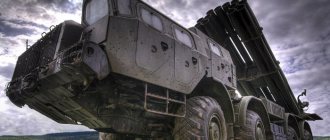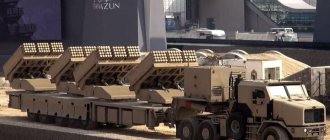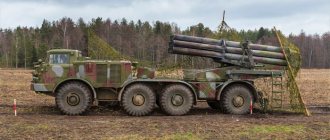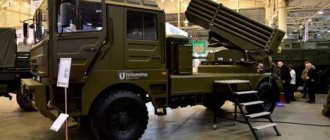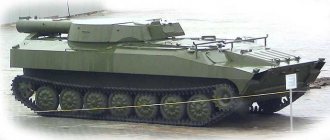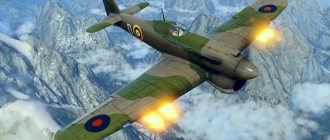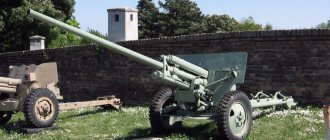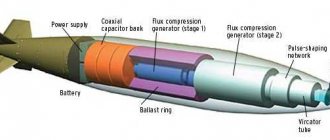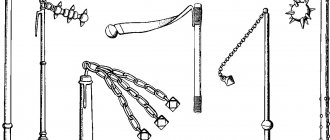Rocket artillery, presented today by the Tornado MLRS, is a completely different type of military. A powerful new weapon created by Russian designers and engineers is radically changing the idea of the massive use of rocket artillery in the front line. The rocket launcher can now fire not just across areas, but is a high-precision weapon capable of causing irreparable damage to the enemy in a matter of seconds.
Looking back to history
Even during the Second World War, it became known what destructive capabilities rocket artillery had. On the Soviet-German front, BM-13 multiple launch rocket launchers mounted on the chassis of a ZIS-6 truck appeared in the summer of 1941. The fire test of the new rocket artillery system took place on July 14, 1941, during stubborn battles with advancing German troops in the area of the city of Orsha. As a result of combat use, it turned out that the new Soviet weapon produced a colossal psychological effect. There was no need to talk about the high efficiency of rocket mortars, since the rockets fired from conventional metal guides did not provide the required hit accuracy. Despite obvious shortcomings in the design of the installation, rocket artillery made its contribution to achieving victory over the enemy.
Only after the war, when completely different technologies appeared, did the USSR manage to create powerful multiple launch rocket systems capable of inflicting serious damage on the enemy, both in manpower and in logistical terms. The first success came with the BM-21 Grad multiple launch rocket system, which first showed its firepower during the Soviet-Chinese armed conflict in the Far East, near Damansky Island. Having received excellent results from the work of Soviet rocket artillery, the Soviet Union decided to create more powerful multiple launch rocket systems. The power could be increased by increasing the caliber of the rockets and increasing the accuracy when firing. Following the Grad MLRS, the Uragan and Smerch rocket systems were adopted by the Soviet Army.
All three multiple launch rocket systems, which appeared during the Soviet Union, continue to be in service with the current Russian army. However, even such successful and successful developments have their own technical and technological resource limits. The main drawback that all of the listed reactive systems suffered from - low accuracy - has now been overcome. Today, the new Tornado MLRS has the best tactical and technical characteristics for rocket artillery. This system can easily be called a weapon of the 21st century, formidable, powerful and high-tech.
Today, when it is already 2022, the new missile launcher has passed State tests. There is no official information yet about the adoption of the new missile system. However, according to various sources, the new system continues to be produced in limited quantities. Today, across the entire armed forces of the Russian Federation, there are only 30-40 new rocket systems, which can be included in individual missile and artillery divisions. It was assumed that the new multiple launch rocket system would be able to completely replace the Grad, Uragan and Smerch MLRS in the troops by 2022, which in most cases have exhausted their technological resource.
Upgrade information
As we have already said, in 1989 the system was modernized. During it, almost all the electronic and radio navigation “stuffing” of the entire complex was replaced:
- The possibility of high-speed exchange of tactical data with headquarters and other Smerch divisions has been added, and the information is encrypted and strictly protected from outside interference.
- Autonomous system for binding to topographical characteristics of the area and displaying this information on electronic displays in real time.
- Automatic calculation of the flight task and its input.
- The ability to fully prepare the installation for firing, including deployment and aiming, without the need for personnel to leave the cockpit.
The future of new weapons
When creating a new multiple launch rocket system, the designers decided to follow the path of unifying the main systems of the new weapon. It was planned to create two modifications at once:
- MLRS 9K51M “Tornado-G” to replace the “Grad” artillery missile systems;
- complex 9K515 “Tornado-S”, to replace the Smerch combat missile systems.
In the first case, we are talking about rocket artillery equipped with 122-mm rockets. The second option involved the creation of a rocket launcher capable of firing 300 mm caliber rockets.
Information that there is also a third version of the Uragan-U MLRS has not been confirmed. Probably, the confusion arose due to the similarity of the name with the Ural car brand, a modification of which was called “Tornado”.
The main innovation that distinguishes the new weapon from its old counterparts is the presence of an automated fire control system (AFCS) “Kapustnik-BM”. In addition, the missile complex received a more advanced transport base. The installation is equipped with new unguided rocket projectiles of 112 and 300 mm caliber.
The maximum flight range of 300 mm caliber rockets is 120 km. This is significantly more than the data possessed by the Smerch missiles. New unguided missiles can be equipped with high-explosive fragmentation or cluster warheads. It is possible to modernize the rocket engines of the missiles, which will increase the flight range to 200 km. During a full salvo, all 40 fired Tornado-G MLRS shells can cover an area of 65 hectares. A missile and artillery division can accordingly cover an area 3-4 times larger.
The system can fire in one volley or in single shots, which indicates the versatility of the system.
Creation of "Tornado-G"
The Tornado-G weapon was developed quite a long time ago. This happened in the 90s. This MLRS was even tested in firing practice near one of the cities of the Russian Federation.
In 2011, a government order was received for the supply of 36 vehicles. The total cost was more than 1 billion rubles. But this order was not carried out. The fact is that this model is, in fact, a modification of the Grad system. As a result, the Tornado-G was not accepted into service. The Russian government revised its decision in 2012, so the delivery of the same number of guns was completed in 2013. They will be assigned to the state fleet.
Design Features
Like its predecessors, the new MLRS has tubular guides assembled into a single unit. On the new Tornado-G vehicle, the number of guides was 30 pieces, two blocks of 12 launch tubes each. For the Tornado-S system, the number of guides is 12 pieces, six pipes in two blocks. Significant changes have also occurred in terms of maintenance of the missile system. The crew of the Tornado MLRS was reduced to 2 people. Full automation of the process reduced the control time allocated for deployment, even taking into account a poorly prepared position. It should be noted that the launcher received a new loading mechanism. Previously, loading of launch tubes was carried out using a crane, one rocket into each tube. The entire loading process could take 15-20 minutes.
In a modern installation, the loading process by the crew is carried out in a matter of minutes. Reload speed is key for this weapon system. The shorter the time interval between salvoes, the higher the probability of fire hitting targets. A delay in reloading may leave the missile launcher vulnerable to a retaliatory strike.
The missile system is installed on the Ural automobile chassis and on MAZ-543M and Kamaz tractors, which have increased cross-country ability. Both variants have completely new remote control guidance systems, thanks to which projectiles are aimed at the target inside the launcher cabin. Manual aiming mode can only be used in exceptional cases. The operator's main job is to control the position of the missile system in relation to the location of the target. The GLONASS navigation satellite system is a mandatory attribute of the new missile and artillery complex. Thanks to its presence, the accuracy of a missile salvo has increased.
Our own GLONASS satellite navigation system, the development of which began back in 1982, can significantly improve the pointing accuracy of modern weapon systems. Today, more than two dozen satellites deployed in orbit, together with relay satellites, provide high accuracy in determining coordinates. Modern missile weapons are equipped with receivers that provide control over compliance with target designations.
Predecessor of "Tornado" - "Grad"
For the first time it became clear how powerful the Grad weapon was after testing it on Damansky Island. Then in 1969, a conflict arose between the border services of China and the Soviet Union. After several shots, the area turned into a plowed field. According to historians, more than 3 thousand Chinese died in that situation. None of those who tried to penetrate the Soviet peninsula (which anyway passed into the possession of the PRC) survived.
The Grad has been in service with the Russian Federation for more than 40 years, and, as you know, everything has a certain “expiration date.” During its existence, the country saw new systems “Smerch” and “Hurricane”. They were replaced by Russia's newest weapon, the Tornado.
Advantages and disadvantages of the BM-13 Katyusha missile launcher
The main advantage of rocket launchers was the large number of projectiles they fired in one salvo. If several MLRS were operating in one area at once, the destructive effect was increased due to the interference of shock waves.
Easy to use. “Katyushas” were distinguished by an extremely simple design, and the sighting devices of this installation were also uncomplicated.
Low cost and easy to manufacture. During the war, the production of rocket launchers was established in dozens of factories. The production of ammunition for these complexes did not present any particular difficulties. Particularly eloquent is the comparison between the cost of the BM-13 and a conventional artillery gun of a similar caliber.
Installation mobility. The time of one BM-13 salvo is approximately 10 seconds; after the salvo, the vehicle left the firing line without exposing itself to enemy return fire.
However, this weapon also had disadvantages, the main one being low shooting accuracy due to the large dispersion of projectiles. This problem was partially solved by the BM-13SN, but it has not been completely resolved for modern MLRS.
Insufficient high-explosive effect of M-13 shells. "Katyusha" was not very effective against long-term defensive fortifications and armored vehicles.
Short firing range compared to cannon artillery.
Large consumption of gunpowder in the manufacture of rockets.
There was heavy smoke during the salvo, which served as an unmasking factor.
The high center of gravity of the BM-13 installations led to frequent rollovers of the vehicle during the march.
